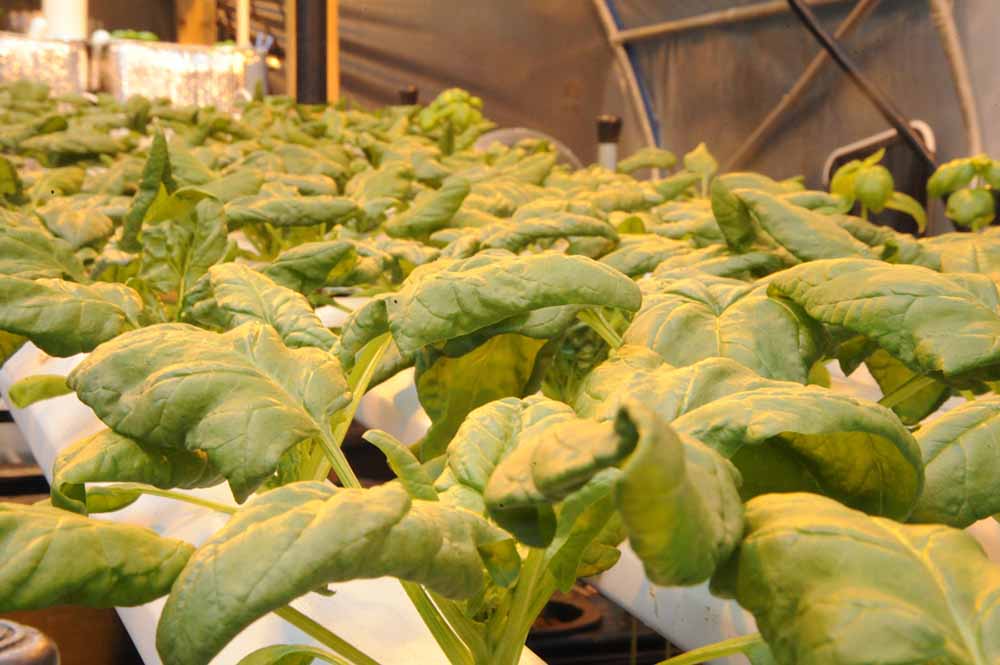

The space station was getting old. By strict accounting, it was approaching a quarter-century hurdling through the thermosphere. It had been host to a variety of esoteric experiments and an even greater variety of human dramas, never broadcast back to the earthlings. Tonight, a new drama was about to unfold: it was time to reseed the food system.
As the station's humans slept the wary sleep of the orbiting, a set of seedlings was being watched by a dully-intelligent machine. The machine had earlier in the day detected that the seedlings had grown robust enough for transfer. Inside the seeding chamber, the temperature was warm and the air damp, but its door withdrew into the casing and the seedling air mixed with that of the main hydroponic chamber. It was the little spinach seedlings' first experience with the cooler, drier atmosphere that would let it thrive into maturity.
The machine's eyes had already identified the mature spinach plants that were the weakest and whose leaves provided the least nutrition to the crew of the station. At this point, the machine had refined its spinach to the point where it could be cut back, harvested, and regrown three times. Of the 12 plants being culled at this juncture, fully 9 of them had survived the triple-harvest and were left withered and dead. The other three had only been harvested twice, but their new leaves were stunted and the machine's spectrographic laser sensor had ranked them at the lowest nutritional value of the 24 plants in the array it cared for. The judgement was swift: the machine's effector carriage homed itself on two axes, traveled to one of the dead plants, extended its scooping tool, and, much like an arcade crane-game, scooped out the plant and its root system, traveled over to the side to its composting antechamber, and finally dropped the plant into the pit.
As the effector traveled to the next dead plant, the antechamber lid closed and it vibrated rapidly, sifting the abiotic growing medium through a mesh grate down into a lower compartment for recycling. When the dead plant was clean of the medium, the grate tilted up and the corpse fell sideways into the compost chamber proper, atmospherically sealed off from the hydroponic compartment. There the plant corpse, along with its other dead or dying brethren, would quickly rot and be churned into a liquid solution which would be added to the hydroponic nutrient solution. The compost had many cycles prior been shown to greatly increase the robustness and nutritional yield of the spinach in the machine.
Once all 12 dead plants had been culled and deposited for compost, the machine turned to the next task. It analyzed the size of the pits in the growth medium left over by its plant-scooping tool and compared them to the ideal for the seedlings' small stonewool cubes, which would be inserted into the medium directly. Once analyzed, the machine meticulously added a small amount of extra growth medium to each pit, once again using its scooping tool and drawing from the medium-recycling chamber next to the composting compartments. Once each pit matched its expectations for how it should look to best receive the seedling cubes, the final step of the process was at hand. Or rather, at effector.
All preceding steps accomplished, the dance of transference could begin. The machine extended its entire seedling tray, which was housed a few inches above the regular hydroponic tray in its separate atmosphere, outward into the hydroponic area, where its carriage-and-gantry-system effector could reach the seedlings. This, of course, was how the machine inserted the seeds into their cubes a few weeks prior. It traveled to the opposite side of the chamber from the compost and medium section, where its other effector tools were stored. It aligned itself with the slot for the scooping tool and carefully inserted its effector into it. It released the tool with a puff of air, and the scoop dropped down half a centimeter into its slot. The effector withdrew and moved sideways to its cube-holding tools, moved over it, and sucked it up onto its effector with another tiny gust of wind. The machine, effector modified, traveled over to the first, most robust seedling and extended its cube holder down to grab it. It lifted it up, withdrew the entire seedling tray to re-expose the hydroponic tray, and traveled to the first open growing pit. The machine extended its cube, and the seedling had a new home.
The process repeated 11 more times, and finally, about an orbit after it had begun, the machine had a new set of roots to feed.

